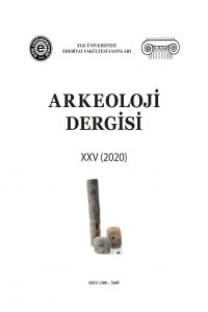Tripolis’ten Bir Grup Kırmızı Astarlı Seramiğin Arkeometrik İncelemesi
Bu çalışmada, Tripolis antik kentinde, 2013-2014 kazı çalışmalarında bulunan, bir grup kırmızı astarlı seramik örneği arkeometrik yöntemlerle incelenmiştir.1 Öncelikle, seramik örneklerinin Munsell Renk Kataloğu'na göre hamur ve astar renkleri belirlendikten sonra, dıştan içe doğru tüm katmanlarını gösterecek şekilde ince kesitleri hazırlanmış ve optik mikroskopta incelenmiştir. Mineral içeriklerinin belirlenmesi için örneklerin X ışınları kırınım (XRD) analizleri yapılmıştır. Buna göre, hamurda belirlenen temel mineraller kuvars, piroksen, hematit, mika / biyotit ve opak minerallerdir. Örneklerin hepsi yüksek derecede pişirilmiştir. Kimyasal analiz çalışmaları sonucunda tüm örneklerin benzer özellikler gösterdikleri belirlenmiştir. Tüm verilerin değerlendirilmesi sonucunda Tripolis'te ele geçen kırmızı astarlı seramiklerin arkeometrik özellikler açısından aynı kökene sahip olduğu, Tripolis'in yerel üretimi olmadığı ve bu kente başka bir coğrafyadan ithal olarak geldiği belirlenmiştir
[ARCHEOMETRICAL INVESTIGATION A GROUP OF RED SLIP WARE FROM TRIPOLIS]
In this study, a group of red-lined ceramic samples found in the excavations of the Tripolis ancient city in 2013-2014 were investigated by archaeometric methods. Firstly, dough and lining colors of ceramic samples were determined according to the Munsell Color Catalog, then thin sections were prepared from outer to inner layers and were investigated under optical microscope. X-ray diffraction (XRD) analyzes of samples were carried out to determine mineral contents. Accordingly, the basic minerals determined in the pulp are quartz, pyroxene, hematite, mica / biotite and opaque minerals. All of the samples were fired at high temperature. As a result of chemical analysis, it was determined that all samples showed similar properties. All the data were evaluated and it was determined that the red slip ware ceramics recovered in Tripolis had the same root in terms of archaeometric properties, however they did not local production of Tripolis, furthermore the samples imported from another geography
___
- Belfiore vd. 2007: C.M. Belfiore, P.M. Day, A. Hein, V. Kılıkoglou, V. La Rosa, P. Mazzoleni, A. Pezzino, “Petrographic and chemical characterization of pottery production of the Late Minoan I kiln at Haghia Triada, Crete”, Archaeometry 49,4, 621-653.
- Bertolino vd. 2009: S.R. Bertolino, V. Galv´an Josa, A.C. Carreras, A. Laguens, G. de la Fuente, J.A. Riveros. “X-ray techniques applied to surface paintings of ceramic pottery pieces from Aguada Culture (Catamarca, Argentina)”, X-Ray Spectrom. 38, 95–102.
- Braekmans vd 2011: D. Braekmans, P. Degryse, J. Poblome, B. Neyt, K. Vyncke, M. Waelkens, “Understanding ceramic variability: an archaeometrical interpretation of the Classical and Hellenistic ceramics at Düzen Tepe and Sagalassos (Southwest Turkey)”, JASc 38, 2101-2115.
- Degryse vd 2003: P. Degryse, J. Poblome, K. Donners, J. Decker, M. Waelkens, “Geoarchaeological investigations of the “potters’ Quarter” at Sagalassos, Southwest Turkey”, Geoarchaeology: An International Journal, 18-2, 255-281.
- Degryse ve Poblome 2008: P. Degryse ve J. Poblome, “Clays for mass production of table and common wares, amphora and architectural ceramics at Sagalassos”, in: P. Degryse, M. Waelkens (Eds.), Sagalassos VI. Geo- and Bio-Archaeology at Sagalassos and in Its Territory. Universitaire Pers Leuven, Leuven, pp. 231-254.
- Duman 2013: B. Duman, “Son Arkeolojik Araştırmalar ve Yeni Bulgular Işığında Tripolis ad Maeandrum” (Tripolis ad Maeandrum: The Latest Archaeological Research Results and New Finds), CEDRUS I, 179-200.
- Duman ve Baysal 2014: B. Duman ve H.H. Baysal, “Tripolis 2. Sezon Kazı ve Restorasyon Raporu: 2013”, KST 36.2, 633-650.
- Duman ve Baysal 2016: B. Duman ve H.H. Baysal, “Tripolis Ad Maeandrum 2014 Yılı Kazı, Onarım ve Koruma Çalışmaları”, KST 37.1, 563-584.
- Duman 2017: B. Duman, “Tripolis 2015 Yılı Kazı, Koruma ve Onarım Çalışmaları”, KST 38.2, 539-562.
- Iordanidisa vd. 2009: A. Iordanidisa, J. GarciaGuineab, G. Karamitrou-Mentessidic, “Analytical study of ancient pottery from the archaeological site of Aiani, northern Greece”, Materials Characterization 60, 292-302.
- Gromet vd. 1984: L.P. Gromet, R.F. Dymek, L.A. Haskin, R.L. Korotev, “The North American Shale Composite”: its compilation, major and trace element characteristics” Geochimica et Cosmochimica Acta 48, 2469-2482.
- Mommsen 2001: H. Mommsen, “Provenance determination of pottery by trace elements analysis: problems, solutions and applications”, Journal of Radioanalytical and Nuclear Chemistry 247, 657–62.
- Ortega vd. 2010: L.A. Ortega, M.C. Zuluaga, A. AlonsoOlazabal, X. Murelaga, A. Alday, “Petrographic and geochemical evidence for long-standing supply of raw materials in Neolithic pottery (Mendandia site, Spain)”, Archaeometry 52, 6, 987–1001.
- Poblome vd. 1993: J. Poblome, R. Degeest, M. Waelkens, E. Scheltens, “Part III. Ceramic Studies Sagalassos Ware”, Sagalassos I, First General Report on the Survey (1986-1989) and Excavations (1990-1991) (Ed. M. Waelkens), Leuven, 113-130.
- Rollinson 1993: H.R. Rollinson, Using geochemical Data: Evaluation, Presentation, Interpretation. Longman Publishing Group, Harlow
- ISSN: 1300-5685
- Yayın Aralığı: Yılda 2 Sayı
- Başlangıç: 1991
- Yayıncı: Ege Yayınları
Sayıdaki Diğer Makaleler
Frigya Dağlık Bölgesi’nde Yer Alan Keçiçayırı İlk Tunç Çağı II Kalesi Küçük Buluntuları
Metropolis Peristilli Ev Mimarisi ve Seramik Buluntuları
Ali Kazım ÖZ, Aygün EKİN MERİÇ
Şarhöyük – Dorylaion Kazılarında Tespit Edilen Erken Tunç Çağı Çanak Çömleği
Mahmut Bilge BAŞTÜRK, Elif BAŞTÜRK
Seyitömer Höyük M.Ö. 5. ve 4. Yüzyıl Ticari Amphoraları
Gökhan COŞKUN, - Fi?gen ÇEVİRİCİ-COŞKUN
Frigya Yaylası’nda Yer Alan Keçiçayırı Yerleşmesi’nde Ele Geçirilen İlk Tunç Çağı Çanak Çömleği
Tripolis’ten Bir Grup Kırmızı Astarlı Seramiğin Arkeometrik İncelemesi
Allianoi’da Saptanan Kemik Buluntular
Parion Nekropolisi M 143 Mezarı ve Buluntuları
